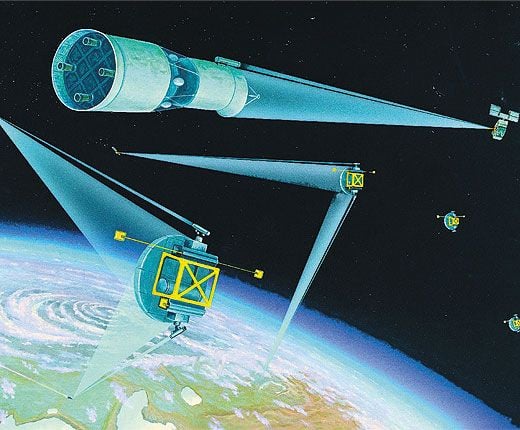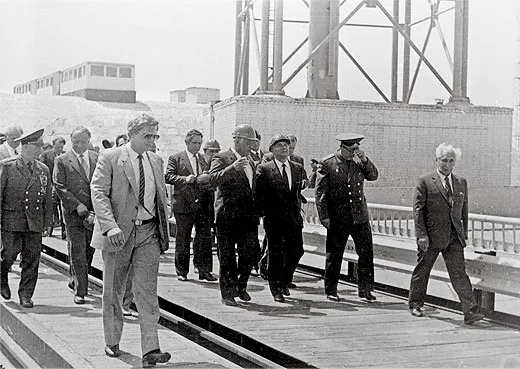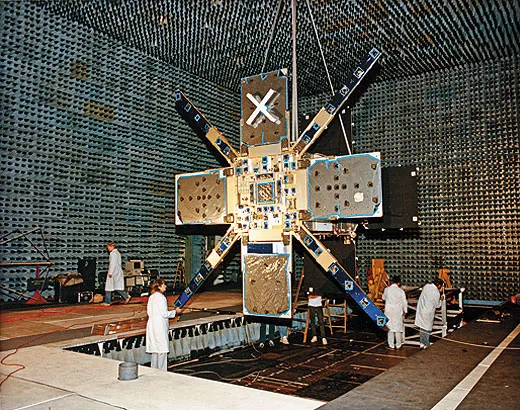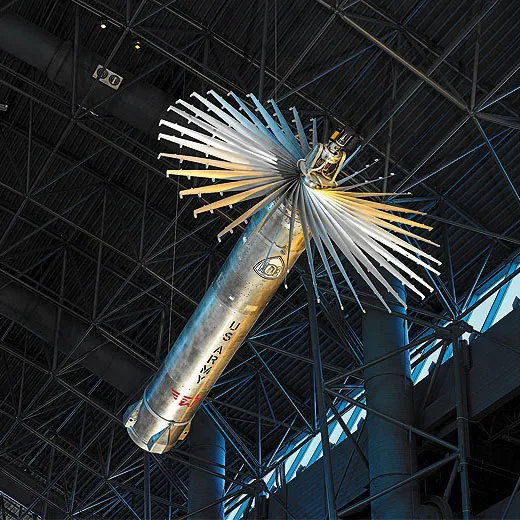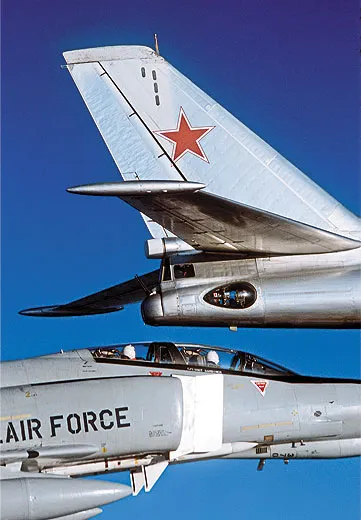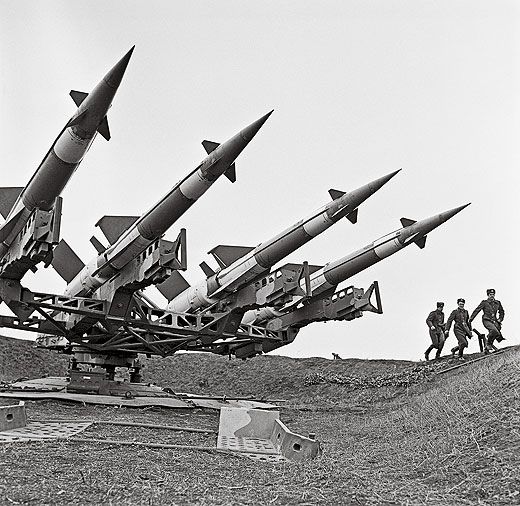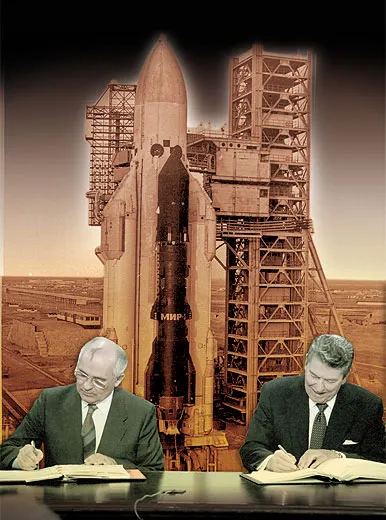Soviet Star Wars
The launch that saved the world from orbiting laser battle stations.
/https://tf-cmsv2-smithsonianmag-media.s3.amazonaws.com/filer/RussianStarWars-flash.jpg)
It sounds like something from a James Bond movie: a massive satellite, the largest ever launched, equipped with a powerful laser to take out the American anti-missile shield in advance of a Soviet first strike. It was real, though—or at least the plan was. In fact, when Soviet President Mikhail Gorbachev walked out of the October 1986 summit in Reykjavik, Iceland, because President Ronald Reagan wouldn't abandon his Strategic Defense Initiative, or SDI, the Soviets were closer to fielding a space-based weapon than the United States was. Less than a year later, as the world continued to criticize Reagan for his "Star Wars" concept, the Soviet Union launched a test satellite for its own space-based laser system, which failed to reach orbit. Had it succeeded, the cold war might have taken a different turn.
The spacecraft was known as Polyus-Skif. "Polyus" is Russian for "pole," as in the north pole. "Skif" referred to the Scythians, an ancient tribe of warriors in central Asia—and the European equivalent of "barbarian."
According to Soviet space scholar Asif Siddiqi, a historian at Fordham University in New York City, Moscow began working on space-based weapons well before Reagan kicked the U.S. program into high gear with his March 23, 1983 Star Wars speech. "[The Soviets] funded two massive R&D studies in the late 1970s and early 1980s to explore how to counter imaginary American missile defense ideas," he says. Two concepts emerged: Skif—a laser "cannon" in orbit—and another weapon known as Kaskad (Cascade), designed to destroy an enemy's satellites with missiles fired from another craft in orbit.
Although some details about these programs leaked out in the mid-1990s, it was not until a few years ago, says Siddiqi, that the full extent of the space weapon plans became known, even in Russia. A former press officer in the Russian space industry, Konstantin Lantratov, pieced together the history of Polyus-Skif. "Lantratov managed to dig deep into the story, and his research clearly shows the enormous scale of these battle station projects," Siddiqi says. "These were not sideline efforts; this was a real space weapons program."
Design work began in the 1970s, not long after the symbolic Apollo-Soyuz "handshake in space" between NASA astronauts and Soviet cosmonauts. The famed Energia organization, which had built the Soyuz crew spacecraft as well as the giant N-1 moon rocket, a program that between 1969 and 1972 suffered four explosions, started studying both the Skif and the Kaskad concepts in 1976. Initially, Energia's plan was to use space-based weapons to shoot down American intercontinental ballistic missiles early in flight, when they were still moving relatively slowly. The Salyut space stations, the first of which was launched in 1971, would serve as the core for either the laser-equipped Polyus spacecraft or the missile-armed Kaskad. The stations could be refueled in orbit and could house two cosmonauts for up to a week.
The designers quickly abandoned this plan, however, and with it the notion of having cosmonauts live on board the Polyus spacecraft. According to Lantratov, the Soviet Ministry of Defense determined that Soviet technology was not up to the challenge of shooting down ICBMs from space, and directed that Skif and Kaskad instead be used to disable American anti-missile satellites—which didn't yet exist, and hadn't even been approved.
Although the United States also had spent considerable amounts of money in the 1950s and 1960s trying to develop a missile defense system, by the mid-1970s this work was winding down, and during Jimmy Carter's presidency, progress on anti-missile systems was minimal. In 1972, both superpowers had signed the Anti-Ballistic Missile Treaty, which limited each to two anti-missile launch sites, one to defend the capital city and one to defend a single base from which ICBMs could be launched.
But the ABM Treaty forbade only the deployment of anti-missile weapons, not testing or development, a loophole both sides exploited. Beginning about 1980, when Reagan won the presidency, scientists at the Lawrence Livermore National Laboratory in California (among them physicist Edward Teller, the so-called father of the H-bomb), along with researchers at other federal labs and a handful of military and civilian policymakers, began looking at "directed energy" weapons—which shoot beams instead of bullets—as a way to neutralize an increasing Soviet advantage in launchers and strategic missiles.
Reagan was taken with the idea, and three years later, in a televised speech on national security, he announced a plan to build a defensive shield to "make nuclear weapons impotent and obsolete," essentially changing the nation's strategic posture from offense to defense. The proposal was immediately attacked by Democrats in Congress, who called it unworkable; it was the late Senator Ted Kennedy who tagged it with the moniker "Star Wars." Despite the skeptics, funding for missile defense increased dramatically, and reached nearly $3 billion a year by 1986.
As prominent planetary scientist and Gorbachev advisor Roald Sagdeev wrote in his 1994 memoir The Making of a Soviet Scientist, "If Americans oversold [the Strategic Defense Initiative], we Russians overbought it." In the summer after Reagan's Star Wars speech, Under Secretary of Defense Fred Iklé requested a CIA study on how the Soviets might respond. The work fell to three analysts, including Allen Thomson, a senior analyst working for the CIA's Office of Scientific and Weapons Research. Thomson had studied other Soviet military research programs, including efforts to develop directed-energy weapons and sensors for space-based submarine detection.
He recalls: "The resulting study basically said that both politically and technically, the Soviets had a very wide range of options for responding to foreseeable U.S. SDI developments." They could build more ICBMs, try to thwart the American missile shield, or attempt to drum up international opposition to the American plan. "There was some recognition that the USSR might be financially strapped if it had to initiate new major weapons systems. But there was no indication that it would be unable to respond," Thomson says.
In fact, Reagan's SDI served as an instant kick in the pants for the Soviet space weapons program, giving the aerospace design bureaus the ammunition they needed to persuade the Politburo to increase funding for Polyus and Kaskad. Both projects had been simmering at the Salyut (now Khrunichev) bureau within Energia, and experiments with high-powered lasers for anti-missile work had been under way since 1981. So far the work had been confined to the laboratory, however. Now, in the wake of Reagan's speech, the rubles started flowing for actual flight hardware. The motive wasn't so much fear that the SDI might prevent Soviet missiles from reaching their targets, but something more ominous, and weirder: a conviction that the Americans were about to set up battle stations in space.
Paranoid fantasies weren't uncommon among senior Soviet generals, according to Peter Westwick, a history professor at the University of California at Santa Barbara who has written about science during the cold war. "They thought that maybe the [U.S.] space shuttle was going to be doing shallow dives into the atmosphere and deploying hydrogen bombs," he says.
Siddiqi elaborates on how the Soviets misinterpreted U.S. intentions for the space shuttle: "To the Soviets, the shuttle was the big thing. It was a sign to them that the Americans were about to move war into space." The official U.S. explanation was that the spaceplane, which debuted in 1981, was to provide routine access to orbit. By the mid-1980s, however, it was also being used to launch classified military satellites (see "Secret Space Shuttles," Aug. 2009). "The shuttle really scared the Soviets big-time because they couldn't figure why you would need a vehicle like that, one that made no economic sense," Siddiqi explains. "So they figured that there must be some unstated military rationale for the vehicle—for example, to deliver and recover large space-based weapons platforms, or to bomb Moscow." The Soviets responded to the perceived threat by building their own space shuttle, a near-exact copy of NASA's, which made a single flight and was then retired in 1993 (see "White Elephant," Dec. 2002/Jan. 2003).
Shortly after Reagan's speech, the Soviet Academy of Sciences was asked to assess whether a space-based missile shield was feasible. Evgeny Velikhov, a prominent physicist, led the study group. Their conclusion, says Westwick, was " ‘We looked at it, we studied it, we determined that it wouldn't work.' " But other Soviet scientists were more alarmist, and succeeded in convincing military and political leaders that even if the SDI wasn't an effective missile shield, it could be used offensively, to hit targets on the ground.
The idea of orbiting lasers shooting at Soviet territory was truly terrifying. According to Westwick, the theories that floated through the Kremlin about the real purpose of the SDI got batty: "Selective political assassination. Say the Politburo is standing outside on May Day and a single laser could take them all out…. These things are overhead, they're invisible, but with zero warning they could zap you."
With such frightening scenarios in mind, the Soviet military accelerated work on the Polyus-Skif laser cannon to destroy SDI satellites. Up until then, the plan had been to use a powerful laser built by the Astrofizika design bureau. But that program had fallen behind; the Astrofizika laser and its power systems were too big and heavy for existing rockets to launch. So when Soviet engineers were told to pick up the pace on Skif, they came up with an interim plan. They would adapt a small, one-megawatt carbon dioxide laser that had already been tested on an Il-76 transport aircraft as a weapon against missiles. In August 1984, the new spacecraft was approved and designated Skif-D, the "D" standing for the Russian word for "demonstration." By January 1986, the Politburo had designated the project as one of the Soviet space program's highest-priority satellites.
Meanwhile, U.S. scientists and engineers were having their own problems with space-based lasers. As research proceeded on projects like Zenith Star, which investigated the problems of placing a two-megawatt chemical laser in orbit, the challenges of building and launching such systems became clearer. The SDI organization funded studies of particle beams and an X-ray laser that would be set off by a nuclear explosion, but none of these projects ever came close to being deployed. By 1986 the SDI leadership was shifting its attention away from orbiting lasers and toward small "kinetic kill vehicles," which could bring down enemy satellites by crashing into them.
The Soviets, though, stayed the course, and kept working on the demonstration version of their space-based laser, with a target launch date of early 1987. Engineers at the Salyut design bureau soon realized that the laser and its power system—even the smaller one already tested on an aircraft—were still too big for the Proton rocket. But a bigger launcher was in the pipeline: The Energia rocket, named after its design bureau, was being built to carry the new Buran space shuttle into orbit. Energia could carry 95 tons to space, so it could carry Skif-D. The rocket was switched. To keep costs down, engineers looked for other existing hardware to modify and incorporate, including elements of Buran and a part of the canceled Almaz military space station designated the TKS, which later became the core module of the Mir space station.
Skif-D grew into a Frankenstein's monster: 131 feet long, more than 13 feet in diameter, and weighing 210,000 pounds, more massive than NASA's Skylab space station. The complex consisted of what the Russians called a "functional block" and a "purposeful module." The functional block was equipped with small rocket engines to place the vehicle into its final orbit. It also included a power system, using solar panels borrowed from Almaz. The purposeful module carried carbon dioxide tanks and two turbo-generators to produce the laser's power, as well as the heavy rotating turret, which pointed the beam. The Polyus spacecraft was built long and thin so that it could fit on the side of the Energia, attached to its central fuel tank.
Designing a laser cannon to work in orbit was no small engineering challenge. A hand-held laser pointer is a relatively simple, static device, but a big gas-powered laser is like a roaring locomotive. Powerful turbo-generators "pump" the carbon dioxide until its atoms become excited and emit light. The turbo-generators have large moving parts, and the gas used in the formation of the laser beam gets very hot, so it has to be vented. Moving parts and exhaust gases induce motion, which poses problems for spacecraft—particularly one that has to be pointed very precisely. The Polyus engineers developed a system to minimize the force of the expelled gas by sending it through deflectors. But the vehicle still required a complex control system to dampen motions caused by the exhaust gases, the turbo-generator, and the moving laser turret. (When firing, the entire spacecraft would be pointed at the target, with the turret making fine adjustments.)
The system was complicated enough that by 1985, the designers knew that testing its components would require more than one launch. The basic Skif-D1 spacecraft structure was proved out in 1987, while the laser wouldn't fly until Skif-D2, in 1988. Around the same time, another, related spacecraft went into development. Designated Skif-Stilet (Scythian-Stiletto), it was to be equipped with a weaker infrared laser based on an operational ground-based system. Skif-Stilet could only blind enemy satellites by targeting their optics. Polyus would have enough energy to destroy a spacecraft in low Earth orbit.
Work on these projects was proceeding at a furious pace throughout 1985 when an unexpected opportunity arose. The Buran shuttle had fallen behind schedule, and wouldn't be ready in time for the planned first launch of the Energia rocket in 1986. The rocket's designers were considering launching a dummy payload instead, and Skif's designers saw an opening: Why not test some of the components of their spacecraft earlier than scheduled?
They quickly drew up plans for a vehicle that would test the functional block's control system and additional components, like the gas ejection vents and a targeting system, consisting of a radar and a low-power fine pointing laser, that would be used in conjunction with the big chemical laser. They labeled the spacecraft Skif-DM, for "demonstration model." Launch was scheduled for fall 1986, which would not affect the launch of Skif-D1, planned for the summer of 1987.
Meeting such a tight deadline had a human cost. At one point, more than 70 firms within the Soviet aerospace industry were working on Polyus-Skif. In his history of the project, Lantratov quotes from an article by Yuri Kornilov, the lead Skif-DM designer at the Khrunichev Machine Building Factory: "As a rule, no excuses were accepted—not even the fact that it was almost the same group of people who, at that time, were performing the grandiose work associated with the creation of Buran. Everything took a back seat to meeting the deadlines assigned from the top."
The designers realized that once they launched the huge craft into space and it expelled large amounts of carbon dioxide, American intelligence analysts would observe the gas and quickly figure out that it was intended for a laser. So the Soviets switched to a combination of xenon and krypton for the Skif-DM venting test. These gases would interact with ionospheric plasma around Earth, and the spacecraft would appear to be part of a civilian geophysics experiment. Skif-DM would also be equipped with small inflatable balloon targets, mimicking enemy satellites, that would be jettisoned in flight and tracked with the radar and the pointing laser.
The launch of the demonstration satellite slipped to 1987, partly because the launch pad had to be modified to accommodate a rocket as heavy as Energia. The technical problems were relatively minor, but the delay had a critical impact on the project's political fortunes.
In 1986, Gorbachev, who had been general secretary of the Communist Party for only a year, was already advocating the sweeping economic and bureaucratic reforms that would come to be known as perestroika, or restructuring. He and his government allies were intent on reining in what they saw as ruinous levels of military spending, and had become increasingly opposed to the Soviet version of Star Wars. Gorbachev acknowledged that the American plan was dangerous, says Westwick, but warned that his country was becoming obsessed with it, and began challenging his advisors: "Maybe we shouldn't be so afraid of SDI."
In January 1987, with Skif-DM's launch just weeks away, Gorbachev's allies in the Politburo pushed through an order limiting what could be done during the demonstration flight. The spacecraft could be launched into orbit, but could not test the gas venting system or deploy any of the tracking targets. Even while the vehicle was on the pad, an order came down requiring several of the targets to be removed, but spacecraft engineers pointed out the dangers of interacting with a fueled rocket, and the order was canceled. Still, the number of experiments was reduced.
That spring, as the booster lay horizontally inside a vast assembly building at the Baikonur Cosmodrome in Kazakhstan, the Skif-DM was mated to its Energia rocket. Technicians then painted two names on the spacecraft. One was "Polyus." The other was "Mir-2," for the proposed civilian space station that Energia's leadership hoped to build. According to Polyus historian Lantratov, that may have been less an attempt to fool foreign spies about the mission's purpose than an advertisement for the Energia company's new project.
The rocket was rolled out to the launch pad and hoisted to the vertical launch position. Then, on the night of May 15, 1987, Energia's engines lit and the giant rocket climbed into the sky. Whereas most launches from Baikonur head for an orbit inclined 52 degrees to the equator, Polyus-Skif traveled farther north, on a 65-degree inclination. If the worst happened, this heading would keep rocket stages and debris—or the entire Skif-DM—from falling on foreign territory.
The Energia rocket performed flawlessly, gaining speed as it rose and arced out toward the northern Pacific. But the kludged nature of the Skif–DM test spacecraft, along with all the compromises and shortcuts, spelled its doom. The satellite's functional block had originally been designed for the Proton launcher, and couldn't withstand the vibration of the Energia's more powerful engines. The solution had been to mount the spacecraft with the control block at the top instead of down near the engines. Essentially, it flew into space upside down. Once the spacecraft separated from its booster, it was supposed to flip around to point away from Earth, with the control block's engines facing down toward Earth, ready to fire and push the craft into orbit.
Skif-DM separated on cue, the spent Energia fell away, and the protective shroud over the front of the spacecraft separated. Then the entire spacecraft, as tall as a 12-story building, began its gentle pitch maneuver. Its tail end, actually the front of the spacecraft, swung up through 90 degrees, through 180 degrees…then kept going. The massive spacecraft tumbled end over end for two full revolutions, then stopped with its nose pointing down toward Earth. In the rush to launch such a complicated spacecraft, the designers had missed a tiny software error. The engines fired, and Skif-DM headed back into the atmosphere it had just escaped, quickly overheating and breaking into burning pieces over the Pacific Ocean.
In the West, the debut of the Energia super-rocket was reported as a partial success; though the satellite had failed, the launcher itself operated perfectly. The U.S. government almost certainly had intelligence sensors pointed at the rocket as it flew, but what the CIA or other agencies concluded about the payload remains classified.
The failure of Polyus-Skif, combined with its immense expense, gave the program's opponents the ammunition they needed to kill it. Further Skif flights were canceled. Hardware being prepared was either scrapped or shoved to the sides of giant warehouses. And the laser never got close enough to launching for anyone to judge whether it would have worked.
In his history of the project, Lantratov quotes Yuri Kornilov, the Skif-DM lead designer: "Of course, no one received any prizes or awards for their feverish, two-year-long, under-the-deadline work. The hundreds of teams that had created Polyus were not given an award or a word of thanks." In fact, after the Skif-DM fiasco, some were reprimanded or demoted.
We still don't know the entire story. "Even today, there's a lot of sensitivity about the whole program," says Siddiqi. "Russians don't like to talk too much about it. And our understanding of Soviet responses to SDI still remains murky. It's clear that there was a lot of internal debate within the Soviet military-industrial elite about the effectiveness of space weapons. And the fact that the Soviets came so close to actually launching a weapon platform suggests that the hardliners were in the driver's seat. It's scary to think what might have happened if Polyus had actually made it to orbit."
Russian space engineers, who are known for being pack rats, may have had the last laugh. The first component of the International Space Station to be launched was the Russian Zarya ("Dawn") module, also known as the Functional Cargo Block. The vehicle was built in the mid-1990s, under contract to NASA, by the enterprising engineers at the Khrunichev factory, who produced it on time and on budget. The main purpose of Zarya is to supply electrical power and to reboost the station, the same role the Skif's functional block would have served. Some Soviet space watchers believe that Zarya began life as a flight spare originally built for the Polyus program. Dusting off old but perfectly usable hardware—or even just blueprints—would certainly have helped Khrunichev meet its production schedule for the space station module during the economic chaos that prevailed in Russia after the cold war. It's only speculation, but if true, it would mean that the old Soviet Union ultimately succeeded in getting a tiny piece of its Star Wars system into orbit. The irony is that the American taxpayer picked up the tab.
Dwayne A. Day is a program officer with the Space Studies Board of the National Research Council. Robert G. Kennedy III is president of Ultimax Group Inc., in Oak Ridge, Tennessee. The authors wish to thank Anton Smirnov for his assistance in translating the Lantranov article.
